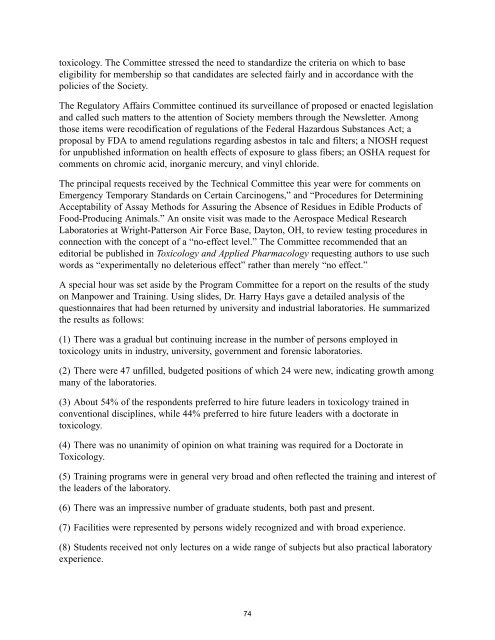SOCIETY O. TOXICOLOGY HISTORY - Society of Toxicology
SOCIETY O. TOXICOLOGY HISTORY - Society of Toxicology
SOCIETY O. TOXICOLOGY HISTORY - Society of Toxicology
Create successful ePaper yourself
Turn your PDF publications into a flip-book with our unique Google optimized e-Paper software.
toxicology. The Committee stressed the need to standardize the criteria on which to base<br />
eligibility for membership so that candidates are selected fairly and in accordance with the<br />
policies <strong>of</strong> the <strong>Society</strong>.<br />
The Regulatory Affairs Committee continued its surveillance <strong>of</strong> proposed or enacted legislation<br />
and called such matters to the attention <strong>of</strong> <strong>Society</strong> members through the Newsletter. Among<br />
those items were recodification <strong>of</strong> regulations <strong>of</strong> the Federal Hazardous Substances Act; a<br />
proposal by FDA to amend regulations regarding asbestos in talc and filters; a NIOSH request<br />
for unpublished information on health effects <strong>of</strong> exposure to glass fibers; an OSHA request for<br />
comments on chromic acid, inorganic mercury, and vinyl chloride.<br />
The principal requests received by the Technical Committee this year were for comments on<br />
Emergency Temporary Standards on Certain Carcinogens,” and “Procedures for Determining<br />
Acceptability <strong>of</strong> Assay Methods for Assuring the Absence <strong>of</strong> Residues in Edible Products <strong>of</strong><br />
Food-Producing Animals.” An onsite visit was made to the Aerospace Medical Research<br />
Laboratories at Wright-Patterson Air Force Base, Dayton, OH, to review testing procedures in<br />
connection with the concept <strong>of</strong> a “no-effect level.” The Committee recommended that an<br />
editorial be published in <strong>Toxicology</strong> and Applied Pharmacology requesting authors to use such<br />
words as “experimentally no deleterious effect” rather than merely “no effect.”<br />
A special hour was set aside by the Program Committee for a report on the results <strong>of</strong> the study<br />
on Manpower and Training. Using slides, Dr. Harry Hays gave a detailed analysis <strong>of</strong> the<br />
questionnaires that had been returned by university and industrial laboratories. He summarized<br />
the results as follows:<br />
(1) There was a gradual but continuing increase in the number <strong>of</strong> persons employed in<br />
toxicology units in industry, university, government and forensic laboratories.<br />
(2) There were 47 unfilled, budgeted positions <strong>of</strong> which 24 were new, indicating growth among<br />
many <strong>of</strong> the laboratories.<br />
(3) About 54% <strong>of</strong> the respondents preferred to hire future leaders in toxicology trained in<br />
conventional disciplines, while 44% preferred to hire future leaders with a doctorate in<br />
toxicology.<br />
(4) There was no unanimity <strong>of</strong> opinion on what training was required for a Doctorate in<br />
<strong>Toxicology</strong>.<br />
(5) Training programs were in general very broad and <strong>of</strong>ten reflected the training and interest <strong>of</strong><br />
the leaders <strong>of</strong> the laboratory.<br />
(6) There was an impressive number <strong>of</strong> graduate students, both past and present.<br />
(7) Facilities were represented by persons widely recognized and with broad experience.<br />
(8) Students received not only lectures on a wide range <strong>of</strong> subjects but also practical laboratory<br />
experience.<br />
74
















